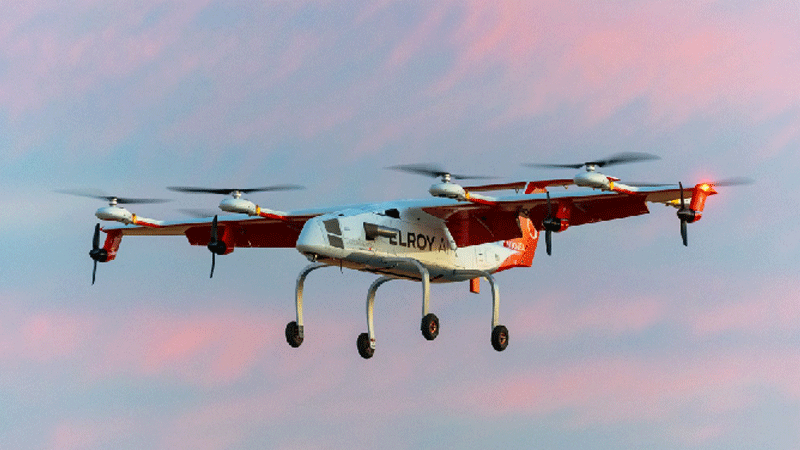Elroy Air achieves industry-first flight of turbogenerator-hybrid hVTOL aircraft

Elroy Air flew the world’s first turbogenerator-hybrid electric vertical take-off and landing (hVTOL) aircraft on November 12 at its test-flight facility in Byron, California - the Chaparral C1. The C1 is an autonomous hVTOL aircraft, with distributed electric propulsion and a turbogenerator-battery architecture. The milestone marks a significant step forward in the company’s mission to enable same-day shipping to every person on the planet and agile, low-risk resupply for Defense.
The Chaparral took flight on November 12 from Byron Airport, where the Elroy Air Team runs flight test operations. Leveraging both its turbogenerator system and high-power batteries the C1 took off vertically, flew for 57 seconds, and landed successfully.
“This is an exhilarating day for our team and the industry as a whole,” said Elroy Air co-founder and CEO Dave Merrill. “In 2017 we had an unconventional idea to develop an autonomous long-range VTOL aircraft that would fill a major capability gap for middle-mile express shipping, humanitarian logistics, and military resupply. On Sunday our Chaparral C1 became the first turbogenerator-hybrid electric hVTOL aircraft to take flight. This marks a major moment for the industry as hybrid-electric aircraft enable the dual benefits of runway-independent safe redundant propulsion, and long-range flight well in excess of battery power alone. Our accomplishment puts Elroy Air one step closer to delivering a transformative logistics capability to our customers and partners.”
Hybrid-electric aircraft represent a critical advancement in the aviation industry. For vertical flight, distributed electric propulsion (DEP) using multiple redundant rotors enables robust and safe operations even in the case of motor failure - a key enabler for autonomy. However, today’s battery-electric eVTOL aircraft designed for Air Taxi and cargo operations are range-constrained due to the energy density limitations of available battery cells, and they must be operated in locations with substantial battery-charging infrastructure. The combination of DEP and turbine-based electrical power generation yields a best-of-both-worlds option first suggested by NASA researchers in 2008. Turbogenerator-hybrid architecture addresses the limitations of all-electric systems by combining a gas turbine-driven generator with batteries - enabling long-range missions (a “must-have” for logistics) without requiring charging infrastructure, as well as safe redundant flight for autonomous operations.
“The use of hybrid electric powertrains is not trivial – balancing battery and turbogenerator power output to respond to load demand requires power management systems that are properly governed to facilitate effective and efficient flight. Such systems for true VTOL and vertical flight capable aircraft are more complex and demanding than for fixed wing systems because of the discrepancies in power requirements in different flight regimes,” explained Ashish Bagai, advanced rotorcraft expert. “This is a major step in the development of hVTOL flight – one that underscores the potential utility value of DEP concepts. It’s very encouraging.”
To develop and bring the world’s first hVTOL air vehicle into flight test, the Elroy Air team overcame substantial technology challenges in electrical power management and structural vibration. The company’s intellectual property and deep accumulated technical experience positions Elroy Air at the forefront of hVTOL aircraft development. Elroy Air’s engineering team is led by Zach Lovering, an aerospace engineer and eVTOL industry veteran who contributed to multiple aircraft development programs at Zee Aero (now Wisk), and subsequently led the pioneering Vahana eVTOL aircraft program at Acubed by Airbus.
“The team at Elroy Air has achieved an exciting milestone with the first flight of their Chaparral aircraft,” said Dr. Mark Esper, 27th US Secretary of Defense and Elroy Air Board Member. “Their work to enable autonomous cargo delivery for the resupply of troops in the field will create a game-changing capability for supporting and sustaining the United States military and allied forces in future campaigns.”
Elroy Air’s Chaparral is in high demand from a number of leading partners in commercial, humanitarian, and defense logistics. Its vehicle backlog - reflected in LOIs and MOUs with a growing number of deposit-backed agreements - today exceeds $3Bn in future revenues. Since starting work with AFSOC in 2019, the company now holds 3 active contracts with US Air Force (SBIR Phase II, SBIR Phase III, and TACFI). The Chaparral’s capabilities address an urgent operational need for logistics in contested environments where today’s alternative is dangerous resupply missions using expensive crewed aircraft, a demand reflected by its active partnerships with the Defense community.
“AFWERX is excited to see the progress in hybrid electric powertrains for transformative vertical lift aircraft. Hybrid flight marks a key technical milestone for the industry to increase VTOL range and payload while validating the investment strategies of both AFWERX Prime and AFVentures TACFI program,” said Col. Elliott Leigh, AFWERX director and chief commercialization officer for the Department of the Air Force.
“They say it takes a village. Without the support of our investors, commercial partners, and the Department of the Air Force’s visionary Agility Prime effort we would not be this much closer to making our vision a reality,” said Elroy Air co-founder and Chief Product Officer Clint Cope.
“This groundbreaking initial flight of the C1 will be followed by an ongoing envelope expansion campaign in coordination with the US Air Force in which we’ll advance the vehicle’s demonstrated flight capabilities through subsequent modes of airborne operations,” said Elroy Air VP of Engineering Zach Lovering. “These modes include expanded hover, system identification, transition, and cruise flight.”








